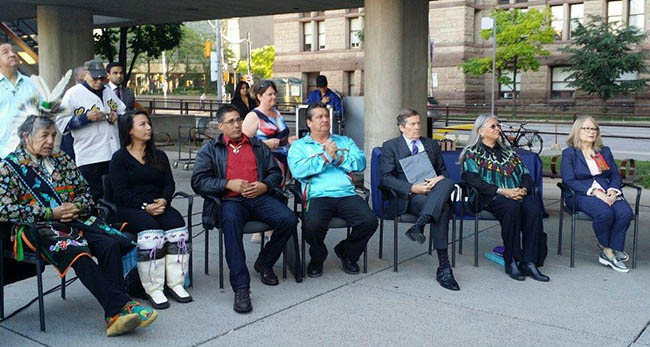Nation flags on permanent display at Toronto’s City Hall

By Barb Nahwegahbow
The Indigenous presence in Toronto, past and present became more visible with the permanent installation of First Nations, Inuit and Metis flags at City Hall on Indigenous Solidarity Day.
The City wanted to commemorate Toronto’s First Peoples through flags belonging to the Indigenous groups who traditionally occupied, and and currently occupy, the territory known as Toronto.
Flags belonging to the following groups were included: The Mississaugas of the New Credit First Nation, Six Nations of the Grand River Territory First Nation, the Huron-Wendat-Wendake First Nation, the Métis Nation of Ontario and the Inuit. The permanency of the flags commemorates Toronto’s location on Indigenous lands.
Indigenous representatives in attendance included Chief Ava Hill, Six Nations of the Grand River Territory; Chief Stacey LaForme, Mississaugas of the New Credit; Akian Sioui, the Huron-Wendat Nation of Ontario and Quebec; Sara Beth Holden, Inuit Tapiriit Kanatami; and Joanne Meyer, Metis Nation of Ontario.
Preceding the installation was a Sunrise Ceremony at 5:30 am in Nathan Philips Square. About 300 Indigenous and non-Indigenous people attended the ceremony conducted by Anishinawbe Traditional Knowledge Keeper Steve Teekens. He gave teachings about the significance of different aspects of the ceremony, and the pipe, water and strawberries were passed to all participants. Most people took the opportunity to offer tobacco at the sacred fire that was in the middle of the circle.
Over the past several years, a Sunrise Ceremony has been held annually on Indigenous Solidarity Day. This year’s record-breaking attendance shows that the ceremony has become a Toronto institution.
Following the ceremony, City Councillor Mike Layton and the Co-Chair of the City’s Aboriginal Affairs said, “Today’s ceremony provides us with an opportunity to celebrate the culture and heritage and significant contributions of the first people to our country and to our city…when we’re doing these lovely ceremonial proclamations, let’s also remember that our true work here at City Hall will be actually putting funding into place.”
Mayor John Tory also acknowledged the contributions of Indigenous people not only to the city but to the country. He spoke about the ceremony that carries respect not just for people, “but also respect for nature,” he said. “I’m always in awe of the fact that Indigenous people show us such an example of stewardship of the environment that we are entrusted with.”
The commemorative Indigenous flags carry with them a reminder that, “there are a lot of unaddressed issues, there’s a lot of unfinished business that we all have to address collectively when it comes to the great history of First Nations and Indigenous people, making sure we honour that history and that we address those issues as we go forward, Mayor Tory said.
“The permanent exhibit of the flags here is a good first step,” said Chief Stacey LaForme. “But this is just the first step,” he continued. “Everybody deserves and needs to see themselves in the world that surrounds them and that includes everybody…the more we do, the better we become.”
Akian Sioui said installation of the flag representing the Huron-Wendat-Wendake Nation means recognition, “that at the beginning, we were here as allies and we’re still here and we share with other nations the knowledge about the traditions, and we need to be involved in the society too.”
The Inuit flag, “is representing that we are here, our population is strong and we’re working together with other Indigenous organizations in Toronto, “said Sara Beth Holden, the President of the Toronto Inuit Association. The Inuit population in Toronto, she said, is about 1,000 and the flag is, “just letting people know that we are here.”
Councillor Mike Layton said the flags will also be permanently displayed at the other four civic centres in Toronto.


